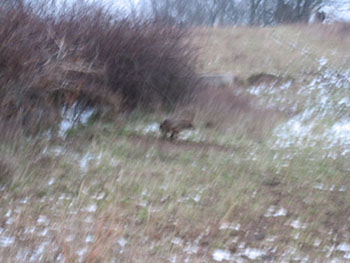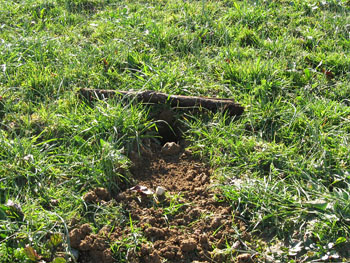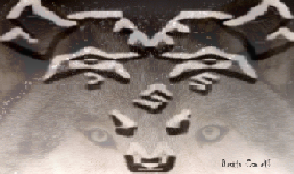Coyote Trapping
Coyotes are a nasty animal. They will eat your cat and kill your dog. Kill and eat livestock and devastate the local game population. Moreover, their range is expanding all the time. Fox trappers east of the Mississippi River are now mainly coyote trappers as the coyotes have scarcefied the previously abundant red fox population.
One of the worst things to do with coytes is to treat coyote trapping like you are trapping a big fox . The range of a coyote is vastly larger than a fox's. A good fox set in a great location may yield results within three days where a good coyote set in a great location could take up to two weeks to connect. Another thing is that coyotes are an extremely paranoid animal. They do a lot of circleling at a set and will work the back of the sets a lot more than what a red fox will.
Traps and Equipment
One of the main differences is coyote trapping verse what you would be doing fox trapping is your traps. Let's face it, it does not take much of a trap to hold a fox. Especially since they do not fight traps hardly at all, they just like to run around in circles. Coyotes will test every part of the trap that an fail and then some. The old stock traps like the #1.5 victor coilspring can be dismantled by coyotes. Every now and then you'll still have a coyote there when you arrive. These days a trap that is beefed up with heavy baseplates, jaw laminations, crunch proof swivels and rod style trap dogs are the way to go for coyote trapping
There are a lot of good traps on the market these days since the expansion of coyotes across the country is nearly complete. Here in Ohio where I live, we are limited traps of six inch inside diameter jawspread for traps that have a gripping surface of 5/16th or greater. Smaller traps under 5 3/8" inside jawspread do not require the increased gripping surface width. With that said, my current weapons for coyote trapping are the Bridger #2 coilspring or the Montana #3 dogless trap both model traps modified with outside laminations, baseplated and four coiled for dealing with frozen clay conditions. These traps are moderately priced and easy to modify yourself. There are many other traps available but these fit my preferences.
THIS PARAGRAPH BELOW IS REQUIRED. FAILURE TO HEED WILL LEAD TO HEARTACHE
Anchoring your coyote traps must be solid unless your terrain is helpful enough for drags and grapples. You cannot single stake coyote traps as you would fox traps unless you are using 30" stakes or long trap chains. Coyotes can and will pump single stakes out of the ground. For coyotes, you should double stake, use drags/grapples or use the disposable stake systems. If you have a lot of rebar stakes, it makes more sense to go with the double stake method. There are a few swivel setups out there commercially or do-it-yourself devices available for you. (I will have some of these methods listed in the Articles part of this site when I get the time.) If you don't have a lot of rebar stakes or walk long distances to make sets, the disposable stakes are great as you can easily carry as many as you need. <
Coyote Location
The places where you set your traps is more important than what kind of set or bait and lure that you use. Coyotes have a large home range and you only have one chance every week or two to catch a coyote on its rounds. Seeing a singular set tracks and a dropping will tell you that a coyotes has been to that particular spot where you are trapping but that does not mean it is the best spot(if your summer trapping hit this spot and back out), though it is a good bet for at least a trap or two. If you find multiple sets of tracks and droppings, you defintely should not pass that location up. You need to identify features that they are attracted to and follow.

Coyotes tend to follow these four features: Rivers, Roads, Ridges and Rows. Rivers are pretty easy to understand, coyotes cannot get across them without swimming or ice on the river or stream so they follow it for quite a long ways, especially ones that just got kicked out of the family territory. Coyotes really like to travel along roads. They can be logging roads, tractor roads, railroads, ATV tracks and highways. Ridges are simply the tops of hills, coyotes like the visibility that these offer. Rows are a little ambiguous, but it is easier to remember "Four R's". These rows can be fencerows, crop edges, wood lines and any other long-running barriers.
Now those features will guide coyotes through an area but still are not great set locations on their own. Its where two or more of these features meet that can make for great set locations. On the other hand, if one of the "4 R's" comes across something like a pond, hay bales, old barns or some object that might provide a gathering spot for coyote prey. For example in the picture above, I caught this coyote next to a tractor road. That brushy area on the left is on a pond dam and there is concrete watering hole just north of the pond. If the animals are in the area and you can find these intersections, you can make just about any set with any bait and lure and catch a few coyotes. Coyotes have a large home range so sets in their hunting areas might not have a coyote come within sight of the set for long periods of time. However, they do travel along their travel ways with much more regularity than their hunting spots.
Coyote sets are not that much difference for fox sets, only the distance from the trap pan to the attractor are different. Fox sets normally have the trap about four inches from center of the trap pan to the attractor. For coyotes, this distance is six to ten inchesif your making "textbook" sets. My placements do not have any hard and fast rules, the trap(or traps on some sets) goes what feels right for that set. This is something that is gained from experience and watching coyotes work sets on nightvision cameras.
The standard sets for coyote are the dirthole and flat sets. There are more sets of course but most of those are a variation of the dirthole or flat set. The mound and trench sets are very effective for coyotes as well but they do take considerably more time to construct.
The dirthole set has been described a thousand times in books and videos and a few times in this site by now, but I will explain my dirthole construction. Digging the hole, I like to use a trowel made by J.C. Connor, its a heavy duty tool and will not bend and fold like other trowels on the market or what you can find at the local hardware store. If I am in softer ground, a tile spade or a cut down, short-handled hardware store spade works great for moving a lot of dirt quickly. The ideal depth for a dirthole is 24 inches. A hole that deep, combined with a good bait, can keep a coyote working your set upto an hour...a shallow hole might get you a minute.
To bed the trap, I start by digging a hole slightly smaller than the set trap. Dig the hole deep enough so that the stake and chain when put in the hole are below the trap enough so that they are not touching the trap.After you stake the trap, place the trap on the top of the hole. Note where the levers are. Pick the trap back up and pound ground the spot where the levers are, the result should be as small as you can get away with and still get the levers in. Pound this area down so that it is about an inch below the ground. Now do the same for the jaws of the trap, remembering to keep the pounding just big enough for the trap to fit. Place the trap back in the bed, if it does not fit, just expand the bed until it fits. Now your trap should be about as solid as you can get it. Test the levers and jaws to make sure and place dirt under the spots where there is a low spot until the trap is solid.
I then pack the small dirt clods that I know will not go through the sifter around the outside of the trap. Sift dirt over the trap until the dirt is about level with or higher than the trap pan. Carefully brush the sifter dirt off the trap pan then pack the dirt around the pan. If you have got the right pan tension on your traps, about two pounds, you do not have to worry about springing the trap with your hands if you use them to pack the dirt. After that is done, sift more dirt over the bed and make sure to leave a slight depression in the dirt above the pan.
Flat sets are not much harder to construct than the dirthole, but more care is needed because the set should match its surroundings, Care must be taken to keep all the dirt in the trap bed. I use the same "pound down" method for bedding my trap. When sifting dirt for a flat set, use your hade to move the dirt in your sifter to keep the dirt from scattering outside the bed. If I am using dry dirt, I just pour the dirt into the bed as I have had the dry dirt pre-sifted. After the trap is bended, blend the bed with grass or whatever happens to be lying nearby so that trap bed looks like the surrounded ground.
For the attractor part of the set, just about anything that stands out can be used. Charred sticks, cornstalks, bones, rocks, bushes and what not can all be used for the attractor. Place it about eight inches from the center of the trap pan and apply lure or urine on it and you are done.
I will start this section with a warning to beginning trappers regarding baits and lures. There is no lure or bait that will catch every animal in the area. In addition, if you do not make sets in good locations, your lure or bait will likely go unnoticed. The trick is to finding the good locations. Now you might have a coyote or two that will ignore or appear to ignore certain bait or lure for various reasons: too loud, or too much used at a set, just not interested. Using a loud lure early in the season may cause a coyote and other animals from approaching the set for a few days. You could also be using to much bait or lure at a set. Canines have sensitive noses and if you use too much lure, they can figure out what it is from a longer distance, which is usually farther away than what your trap is. Using a pea-sized gob is all you need and will cause the canine to come closer to the set to get a better whiff of the lure. Sometimes, the lure or bait you are using just does not appeal to the animal for whatever reason. I will get to a few of these reasons later.
Now that I have gotten the basis of the lure maker’s disclaimer out of the way, if someone does say that their lure will catch everything around you might need to look elsewhere, I'll get down to business. I have covered the different types of lures and baits in the 'Fox Tips' page and I will do a quick rehash here.
Baits are pretty self-explanatory. Bait can be any kind of piece of meat that you have like: muskrat, beaver, groundhog, horse, mutton, fish, etc. It can be used as it is or ground, liquefied, or combined with other meats. Ground meat baits are better than just a regular piece of meat at a set for one reason, when the coyote tries to get the bait out, a chunk piece can be removed with one swipe where a ground or liquefied bait is harder for the canine to remove. A benefit of being harder to remove is that the coyote must move its feet around the set more giving you better odds of catching the coyote. Liquid baits are simply baits that have been liquefied. The thing that makes liquid baits great is that they usually have a few other ingredients and meats added together and when used at a set, it is impossible to remove from the hole.
Using the right bait for the time of the year is critical when trapping. In the early season, coyotes still have a good supply of rabbits, mice and whatever else they have in the area to eat. Using a rotten smelling bait will tend to be ignored. A fresh bait will hold a lot more attraction. As the season gets older and colder, the local food supply starts to get sparse, so a little louder bait starts to be more attractive to coyotes. By louder, I mean that it has a stronger smell to it. As the weather turns colder, the smell from the bait does not disperse as much as it did earlier in the year. Baits with a little bit of skunk essence can be real effective this time of year.
Well the baits are pretty simple to understand so let us turn to lures, which can be a bit more complicated. Lures come in four main categories: food, gland, curiosity and call lures. Food lures are simply lures that has a food smell to them. Gland lures are made from glands from particular furbearers. Normally you should be using the gland lure for the species you are trapping. If your trapping red fox use red fox gland lure, if trapping coyote, use coyote gland lure. Sometimes using a gland lure from another species other than what you are trapping can be a very effective. Curiosity lures are generally food or gland lures combined with other smells that creates some curiosity in the coyote. Call lures are usually one of the above lure categories spiked with a skunk essence or other strong smelling ingredients. They are used early in the year away from your set to bring an animal into the area and later in the year right at the set where you need a stronger smell.
All information on this site is © by Dustin Caudill.
E-mail for permission to use information or picture at webmaster@sniperstrappingplace.comCoyote Sets

Baits and Lures
